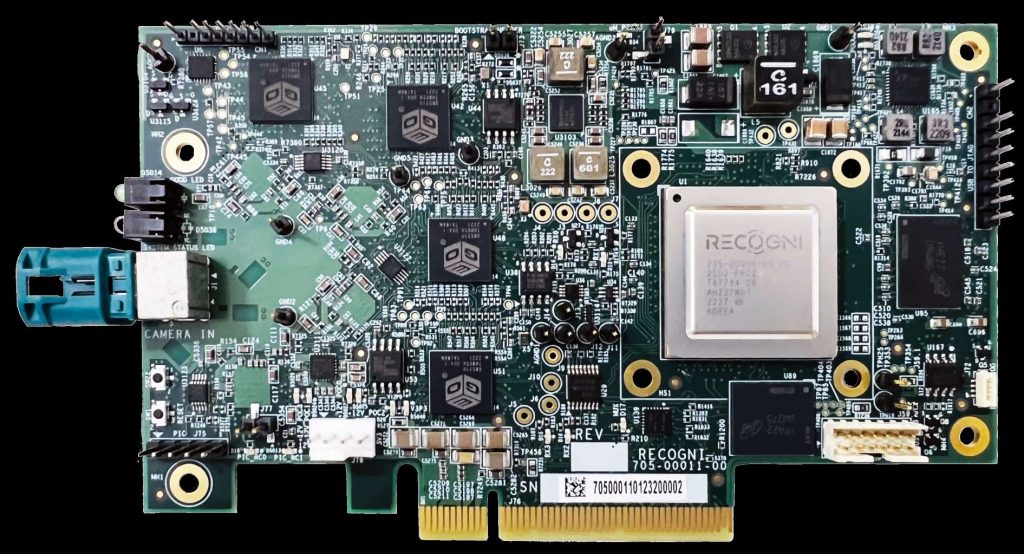
San Jose, CA-based AI-processing startup Recogni Inc. today announced the availability of Pegasus, a PCIe card that allows its Scorpio, what it says is the world’s first 1000 TOPS (trillion operations per second) class inference solution, to be configured for any autonomous mobility application. When using Pegasus in conjunction with its SDK, the company says that customers can better experience Scorpio’s high compute capabilities paired with low power consumption, latency, and system cost.
“The need for autonomous capability is growing rapidly across all forms of transportation, and Recogni is committed to providing the most powerful, purpose-built solutions for autonomous mobility, regardless of use case,” said Marc Bolitho, CEO of Recogni. “Being able to easily integrate Scorpio into any autonomous mobility application with our new Pegasus PCIe card and Recogni’s SDK showcases the multiplatform flexibility, as well as the robustness and readiness of our solutions.”
One Pegasus card can process up to four 8-megapixel cameras to provide front and surround views, and it uses the SDK to convert, compile, profile, and deploy models. Perception output includes the detection of 3D objects, vulnerable road users, lanes, free spaces, and traffic lights/signs. This makes Pegasus a flexible solution for a variety of autonomous mobility applications including autonomous robotaxis, trucks, drones, delivery vehicles, and aviation.
Unlike traditional solutions that are based on legacy technology and repurposed for the monumental task of AI perception processing for autonomous mobility, Recogni’s system is purpose-built to overcome compute and power efficiency barriers specific to autonomous mobility.
“Having been in the automotive and autonomous driving industry for decades, it became clear that autonomous capabilities would only be able to go so far when using existing technology,” said Dr. Yvonne Lutsch, Investment Principal, Bosch Ventures. “Recogni has proven that to move the industry forward, it requires purpose-built technology that is powerful, flexible, and easy to integrate. And Recogni continues to demonstrate their credibility as an autonomous technology provider.”
In the lead-up to Pegasus announcement, R K Anand, Founder & Chief Product Officer at Recogni Inc., and Mansour Behrooz, Vice President of Marketing and Business Development at Recogni Inc., explained to Inside Autonomous Vehicles the value of building a Phoenix reference system for customers. The combination of accelerators and Scorpio tied to a central-ECU host can more easily deliver perception and driving functions for ADAS and AV testing. At CES, the company announced a system that could take either one or two Scorpio chips in a system-on-module that connects to a Renesas V4H host.
“That became the platform that we demonstrated and showed to customers, and it allowed you to go anywhere from 150 to 2000 TOPS,” said Anand.
That meant customers could put it in a range of low-, mid-, or high-end vehicles, depending on the applications they wanted to drive and run. Customers are evaluating and running their workloads on it, but others wanted more flexibility, without a preordained host, so they could choose from Renesas, Qualcomm, Infineon, or TI hosts.
That’s where the PCIe card comes in, which can be plugged into any host that’s X86- or ARM-based, giving greater flexibility. Customers can plug 1-4 PCIe cards, each of which can handle 4 cameras, into a chassis or rack system to hook up 4-16 camera systems to their host of choice. The host combines the card with other peripherals like radar processing and fuses the data to detect cars or pedestrians to run a path-planning or control application.
Initially, customers were skeptical of the game-changing performance claims, so in demos Recogni used voltmeters hooked up to show just 30-W full-system and 6-W chip power consumption when running a 120-TOPS workload. So, how is Recogni able to deliver so much power so efficiently?
“This comes from computer architecture 101 fundamental approach to problem-solving,” said Anand. “We actually do most of the math in the log domain, so you can increase compute by an order of magnitude or two and you could burn power one order of magnitude lower than the others. These are patent-protected approaches, and we have demonstrated results that match the state-of-the-art of any other vendor in the market.”
“We do everything in mirror memory, so we don’t go off the chip,” added Behrooz. “And then, instead of doing the typical multiply, because we go to log, we can do a lot of ads, which is far less power-hungry and much more silicon efficient. And this is where our die size ends up being a lot smaller.”
A startup going after the 900-lb AI-chip heavyweights of Nvidia and Qualcomm is a big challenge, but Recogni is seeing more success with recent developments.
“With the releases of the SDK and Pegasus, we are seeing much more interaction,” said Behrooz of overcoming the education of its customers and building new business. “The challenge really is time-to-revenue. I used to be in the consumer world, and there is no back-to-school [in automotive].”

